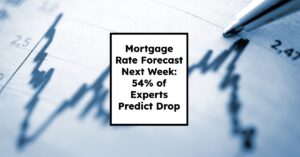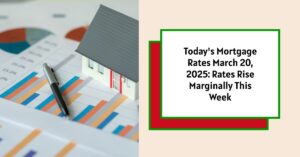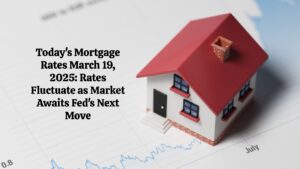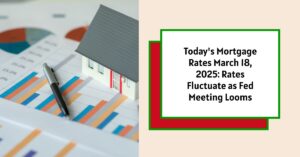Are you hoping to buy a home or refinance soon? If so, you're probably glued to news about the Federal Reserve and mortgage rates. The big question on everyone's mind is: Will mortgage rates go down after the Fed decided to hold interest rates? The short answer is: Don't expect a dramatic drop immediately. While the Fed's actions influence the broader economy, mortgage rates are a different beast, heavily influenced by factors like Treasury yields and inflation. Let’s dive into why.
Will Mortgage Rates Go Down After Fed's Latest Decision to Stay Put?
Understanding the Fed's Recent Decision
On March 19, 2025, the Federal Reserve announced it would keep the federal funds rate steady. This might seem like good news for homebuyers, but the reality is more complicated. You see, the Fed doesn't directly control mortgage rates. What they do is influence the overall economic environment through short-term interest rates. Their decision to hold rates steady reflects their concern about inflation still being above their target and uncertainty in the global economy.
Think of it like this: the Fed is like the captain of a big ship (the U.S. economy). They use interest rates as a rudder to steer the ship in the right direction, hoping to achieve stable prices (low inflation) and full employment.
Here's a quick breakdown of the factors influencing the Fed's decision:
- Inflation Concerns: Inflation is still above the Fed's comfort zone.
- Economic Uncertainty: Geopolitical issues and potential tariffs add to the uncertainty.
- Future Rate Cut Expectations: The market expects rate cuts later in the year, but nothing is set in stone.
The Tricky Relationship Between the Fed and Mortgage Rates
It's important to understand that mortgage rates aren't directly controlled by the Fed. The 30-year fixed mortgage rate is most closely tied to the 10-year Treasury yield. This is because mortgage-backed securities are often benchmarked against these yields.
So, what exactly is the 10-year Treasury yield? Well, it reflects what investors are willing to accept as a return for lending money to the U.S. government for 10 years. These yields are influenced by a number of factors, including inflation expectations, economic growth prospects, and global demand for U.S. debt.
Key takeaway: Mortgage rates are influenced by a broader set of factors than just the Fed's actions.
What Are Mortgage Rates Doing Right Now?
As of March 2025, mortgage rates are hovering around the 6.6% to 6.7% range. Here’s a snapshot from different sources:
| Date | Source | 30-Year Fixed Rate | Notes |
|---|---|---|---|
| March 16, 2025 | Zillow | 6.59% | Up slightly from the previous week |
| March 17, 2025 | Forbes Advisor | 6.72% | Increased compared to the week prior |
| March 20, 2025 | Freddie Mac | 6.67% | Increased for the week ending March 20 |
These rates are lower than the peak we saw in October 2023, but still significantly higher than the lows of 2020 and 2021.
Why Past Fed Actions Didn’t Always Lead to Lower Mortgage Rates
Here's where it gets interesting. Back in 2024, the Fed actually cut interest rates. You'd think that would mean lower mortgage rates, right? Wrong! In fact, mortgage rates increased after the Fed rate cuts.
This highlights the fact that market forces, particularly expectations about future inflation, can often override the Fed's influence on mortgage rates. Even though the Fed was making money cheaper for banks, investors were demanding higher returns on long-term bonds, which in turn pushed mortgage rates up. The increasing 10-year Treasury yield despite Fed cuts in 2024 is an example of this.
Expert Predictions: What to Expect for the Rest of 2025
So, what are the experts saying about the future of mortgage rates? The general consensus is that we're unlikely to see a dramatic drop anytime soon.
- Fannie Mae predicts mortgage rates will average around 6.8% for the year, with a possible dip to 6.6% by year-end.
- Other experts believe rates will remain in the mid-6% range, with slow and steady changes.
My take: I think these predictions are reasonable. We're in a period of economic uncertainty, and inflation is proving to be stickier than many had hoped.
Recommended Read:
Mortgage Rates Drop: Can You Finally Afford a $400,000 Home?
Expect High Mortgage Rates Until 2026: Fannie Mae's 2-Year Forecast
Key Factors Affecting Mortgage Rates in 2025
Here's a table summarizing the key factors that will influence mortgage rates this year:
| Factor | Current Status (March 2025) | Impact on Mortgage Rates |
|---|---|---|
| 10-Year Treasury Yield | Around 4.5%–5% | High yields push rates up |
| Inflation | Around 3%, above Fed's 2% target | Higher inflation expectations raise rates |
| Fed Funds Rate | Held at 4.25%–4.5%, potential cuts later in 2025 | Indirect, affects market expectations |
| Housing Market Demand | Low inventory, high home prices, slow sales | Strong demand can increase rates |
| Global Demand for U.S. Debt | Uncertain, influenced by tariffs and geopolitical risks | Can affect Treasury yields and rates |
What This Means for You: Advice for Homebuyers and Borrowers
Okay, so what should you do with all of this information? Here's my advice:
- Don't expect a big drop in rates anytime soon. Focus on factors you can control, like your credit score and down payment.
- Shop around for the best rates. Don't just go with the first lender you find. Compare offers from multiple lenders to see who can give you the best deal.
- Consider an Adjustable-Rate Mortgage (ARM). If you plan on moving in a few years, an ARM might be a good option. Just be aware of the risks involved if rates rise during the loan term.
- Think long-term. Buying a home is a major financial decision. Focus on whether you can comfortably afford the monthly payments over the long haul, rather than trying to time the market perfectly.
- Be patient. The market will fluctuate.
The Bottom Line
The Federal Reserve's decision to hold interest rates steady doesn't automatically translate into lower mortgage rates. A range of economic factors will dictate where they head in the coming months. Although inflation is still a hurdle to cross over, there's still a possibility that we could see mortgage rates gradually moving downwards toward the end of 2025. For now, the most important thing is to stay informed and make smart financial decisions.
My Personal Thoughts: Having navigated the housing market for years, I've seen firsthand how unpredictable mortgage rates can be. It's easy to get caught up in trying to predict the market, but the most important thing is to focus on your own financial situation and make a decision that's right for you.
Work With Norada, Your Trusted Source for
Real Estate Investments
With mortgage rates fluctuating, investing in turnkey real estate
can help you secure consistent returns.
Expand your portfolio confidently, even in a shifting interest rate environment.
Speak with our expert investment counselors (No Obligation):
(800) 611-3060
Also Read:
- Will Mortgage Rates Go Down in 2025: Morgan Stanley's Forecast
- Mortgage Rate Predictions 2025 from 4 Leading Housing Experts
- Mortgage Rates Forecast for the Next 3 Years: 2025 to 2027
- 30-Year Mortgage Rate Forecast for the Next 5 Years
- 15-Year Mortgage Rate Forecast for the Next 5 Years
- Why Are Mortgage Rates Going Up in 2025: Will Rates Drop?
- Why Are Mortgage Rates So High and Predictions for 2025
- Will Mortgage Rates Ever Be 3% Again in the Future?
- Mortgage Rates Predictions for Next 2 Years
- Mortgage Rate Predictions for Next 5 Years
- Mortgage Rate Predictions: Why 2% and 3% Rates are Out of Reach
- How Lower Mortgage Rates Can Save You Thousands?
- How to Get a Low Mortgage Interest Rate?
- Will Mortgage Rates Ever Be 4% Again?











